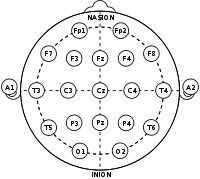
Photo from wikipedia
Abstract Head circumference in infants has been reported to predict brain size, total grey matter volume (GMV) and neurocognitive development. However, it is unknown whether it has predictive value on… Click to show full abstract
Abstract Head circumference in infants has been reported to predict brain size, total grey matter volume (GMV) and neurocognitive development. However, it is unknown whether it has predictive value on regional and subcortical brain volumes. We aimed to explore the relationship between several head circumference measurements since birth and distributions of GMV and subcortical volumes at later childhood. We examined seventy-four, Caucasian, singleton, term-born infants born to mothers randomised to receive fish oil and/or 5-methyltetrahydrofolate or placebo prenatal supplementation. We assessed head circumference at birth and at 4 and 10 years of age and cognitive abilities at 7 years of age. We obtained brain MRI at 10 years of age, on which we performed voxel-based morphometry, cortical surface extraction and subcortical segmentation. Analyses were controlled for sex, age, height, weight, family status, laterality and total intracranial volume. Prenatal supplementation did not affect head circumference at any age, cognitive abilities or total brain volumes. Head circumference at 4 years presented the highest correlation with total GMV, white matter volume and brain surface area, and was also strongly associated with GMV of frontal, temporal and occipital areas, as well as with caudate nucleus, globus pallidus, putamen and thalamus volumes. As relationships between brain volumes in childhood and several outcomes extend into adulthood, we have found that ages between 0 and 4 years as the optimal time for brain growth; postnatal factors might have the most relevant impact on structural maturation of certain cortical areas and subcortical nuclei, independent of prenatal supplementation.
Journal Title: British Journal of Nutrition
Year Published: 2017
Link to full text (if available)
Share on Social Media: Sign Up to like & get
recommendations!